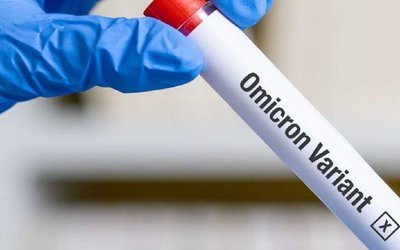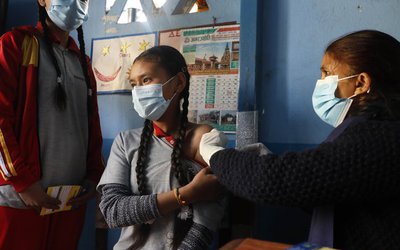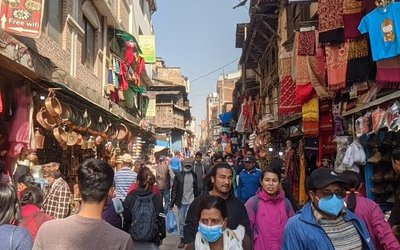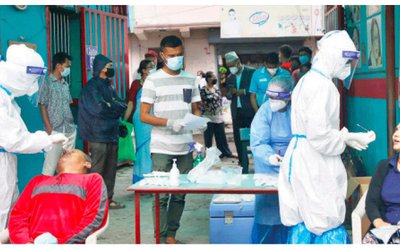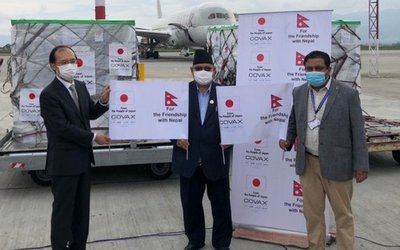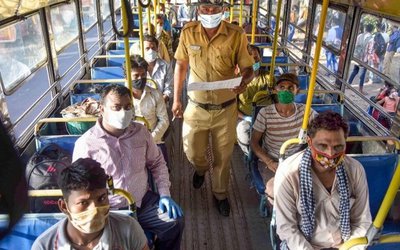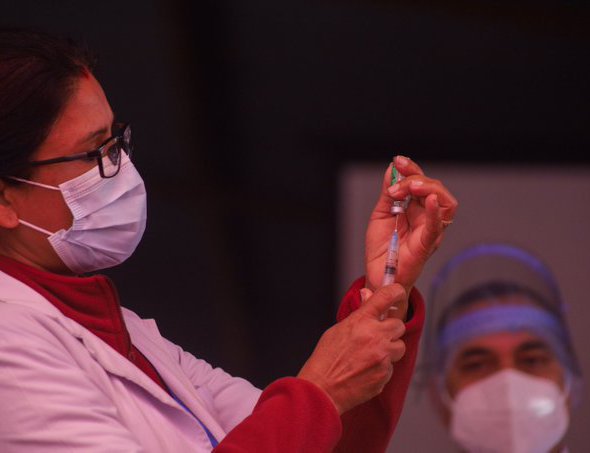
At a time when COVID-19 infections surge again in Nepal, the announcement of the World Bank to provide 4 million doses of Moderna Vaccines through COVAX is highly significant and important.
According to the World Bank, Nepal will get 4 million doses soon. Nepal is the second country globally to have completed agreements with GAVI to procure 4 million doses of Moderna vaccines. Financed by the World Bank, through the COVAX cost-share option, this will diversify and strengthen the country’s COVID-19 vaccine portfolio.
“Nepal is an early mover in utilizing the COVAX cost-share scheme, and I am pleased to note that we have finalized an arrangement, despite very challenging circumstances, to bring safe and highly effective vaccines to Nepal,” said Umesh Shrestha, Minister of State for Health and Population. “Moderna vaccines have helped expand options for vaccinating Nepalis above 12 years of age and fast-track Nepal’s progress towards a safer post-COVID world.”
Delivery of these vaccines is expected to start by March 2022 and will contribute to Nepal’s goal to vaccinate at least 72 percent of its population, as well as children 12-17 years of age for whom the Moderna vaccine is deemed safe and effective.
“We are honored to support the people and Government of Nepal, along with our development partners, by financing the purchase of safe and effective vaccines through the COVAX facility,” said Faris Hadad-Zervos, World Bank Country Director for Maldives, Nepal, and Sri Lanka. “This is a key element of our overall COVID response by helping to meet emergency health needs and strengthening the healthcare and vaccine delivery system.”
The World Bank has made available $104 million to support the Government of Nepal’s health response to the pandemic, with $67.5 million earmarked to purchase and deploy COVID-19 vaccines. Last month, 1,000 oxygen concentrators were brought in through the project while seven oxygen generation plants are being established, one in each province. These will help strengthen health preparedness in the event of future waves of the pandemic.
“We commend the Government of Nepal for being the first country in South Asia, and one of the first in the world, to join and tap into the COVAX cost-share option,” said Hartwig Schafer, World Bank Vice President for South Asia. “The World Bank is committed to continuing our support to Nepal’s COVID-19 vaccination program, which is critical to helping the people and economy of Nepal build back better from this unprecedented crisis.”
The World Bank supports countries’ COVID-19 vaccine implementation plans. Countries make choices based on their specific needs and the WHO’s recommended policy and guidelines on vaccines, therapeutics, and other tools they adopt. As the threshold for eligibility for IBRD/IDA resources in vaccine purchase, the Bank accepts as eligible for inclusion in the project COVID-19 vaccines that (i) have received regular or emergency licensure or authorization from at least one of the Stringent Regulatory Authorities (SRAs) identified by World Health Organization (WHO) for vaccines procured and/or supplied under the COVAX Facility, as may be amended from time to time by WHO; or (ii) have received WHO Prequalification or WHO Emergency Use Listing. The Moderna vaccine meets these criteria.
Nepal’s COVID-19
Nepal’s COVID-19 cases have started to rise again. However, this surge is concentrated in Kathmandu Valley. This rise is a natural outcome of early opening of the valley without making proper preparations and judging the consequences.
Following two and three months of loose lockdown, Nepal has completely opened all the activities just after the change of new government. Even political rallies and other such activities have been frequent. Many people have not followed the health protocol, including masking and social distance. Thus, the achievement Nepal has made to contain the virus to its limit has vanished overnight.
Although the number of positive cases increases in the valley, the good news is that the rate of hospitalization has declined compared to early second wave. With highly dense population and frequent visits by people from different parts of Nepal, Kathmandu Valley is very much vulnerable to upsurge.
With the COVID-19 testing facilities available easily, Kathmandu valley has highest number of testing compared to other cities.
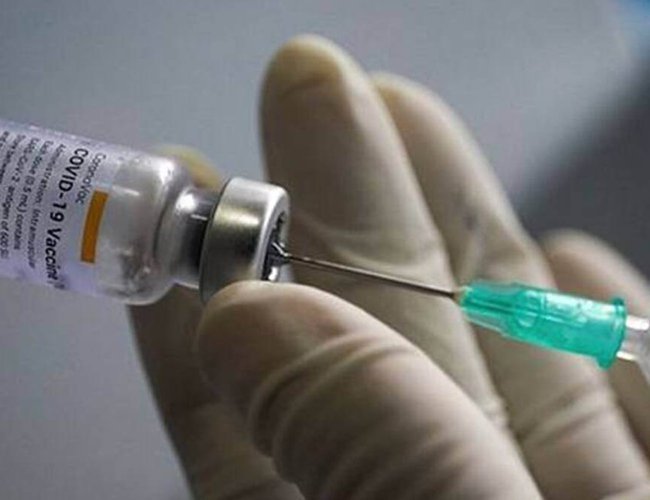
Ministry of Health and Population showed that in over 60 percent of testing, the data is coming from Kathmandu Valley. This may be the reason the number of positive cases has gone up.
Understanding its vulnerability compared to other cities, Ministry of Health has decided to increase the vaccination quotas for Kathmandu Valley in other big cities of Terai.
As the Intensive Care Units (ICUs) have already been packed with virus-infected patients in hospitals in the valley, there would be shortage of general beds in the upcoming days if the cases continue to surge in the same rate.
Dr. Anup Bastola, director at Sukraraj Tropical and Infectious Disease Hospital said that the flow of COVID-19 patients had increased in the hospital in the last 15 days.
"Of the 40 beds separated for infected patients, 25 are currently occupied. Similarly, the 24-bed ICU has already been packed," said Dr. Bastola. He added that of the infected patients admitted to the hospital, maximum were from out of the Valley.
The situation is similar to TU Teaching Hospital, Maharajgunj as it has also seen a rise in the flow of infected patients. "All 40 ICU beds have been filled with COVID-19 patients and of them, 17 are in ventilator," said Dr. Santa Kumar Das, COVID focal person at TUTH, adding, "The hospital has separated 115 general beds for treatment of virus-infected people and of them, 85 are currently occupied."
Along with public hospitals, the situation in private hospitals is also the same. All 13 ICU beds at HAMS hospital have been filled with infected patients. "Currently, five patients are under treatment with ventilator facility. Also, 42 out of 49 general beds are also in use for the treatment of infected people," said Rajbhandari.
The recent surge in cases of novel coronavirus infection has also impacted COVID Unified Hospital. Dr. Bhupendra Bahadur Basnet, chief administrative officer at the hospital, said that the number of virus-infected patients visiting the hospital was increasing day by day.
The hospital has 163 general and High Dependency Unit (HDU) beds and 40 ICU beds. "Currently, 20 are under treatment in the ICU and 88 patients are admitted to the general beds," said Dr. Basnet, adding that all the hospitals might be overflowed with COVID-19 patients if the daily infections continued to increase in the same manner.
According to Dr Jhalak Sharma Gautam, chief of the National Immunization Programme, about 4,570,553 people have received their first COVID-19 shot. This makes 9.52 per cent of the total population, he added.
Of the three types of a vaccine against COVID-19, among Covieshield, Johnson & Johnson and Vero Cell are being administered in Nepal. As many as 4,570, 553 people have received their doses of the aforementioned vaccine.
Whereas 2,888,360 have received their full dose till now.
For an estimate, in 24 hours, 69,037 people have been vaccinated with the second dose of the Covishield vaccine, 28,871 and 69,111 people have been vaccinated with the first dose and second of the Vero cell vaccine respectively as well as 28,192 people have been vaccinated against Johnson & Johnson.
At the same time, the total number of people receiving a complete shot of the Covishield vaccine has reached 597,819, according to the ministry.
The number of first doses and second doses of the Vero Cell vaccine has reached 272,128 and 1,083,403 respectively. So far, 127,138 people have been vaccinated with Johnson & Johnson vaccine.
As vaccination drive continues and cases of hospitalization of vaccinated people are fewer, there are hopeful signs that the vaccination campaign will help contain COVID-19.
- FOREIGN EXCHANGE: Largest Deposit
- Jul 22, 2024
- IMF: Approval Of SDR
- Jul 22, 2024
- NEPAL-KOREA RELATIONS: Fifty-Years Of Warm Relations
- May 31, 2024
- NEPAL-BRITAIN: Centenary Celebration
- May 31, 2024
- POLITCS: Forming New Alliances
- May 27, 2024

